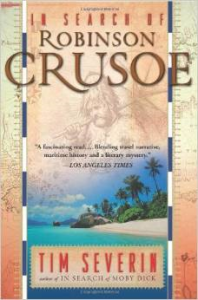 We here at WoWasis reviewed Diana Souhami’s Selkirk’s Island: The True and Strange Adventures of the Real Robinson Crusoe a while back. It’s a great story about a compelling but unlikeable character, Alexander Selkirk, marooned alone for 52 months on an island in the Pacific. But as author Tim Severin discovered, Selkirk, while inspiring Daniel Defoe’s character, probably wasn’t his model. That honor would go to Henry Pitman.
We here at WoWasis reviewed Diana Souhami’s Selkirk’s Island: The True and Strange Adventures of the Real Robinson Crusoe a while back. It’s a great story about a compelling but unlikeable character, Alexander Selkirk, marooned alone for 52 months on an island in the Pacific. But as author Tim Severin discovered, Selkirk, while inspiring Daniel Defoe’s character, probably wasn’t his model. That honor would go to Henry Pitman.
Severin tells all in his book In Search of Robinson Crusoe (2002, ISBN 0-465-07698-X). The author is an adventurer/detective who’s written a number of books following up on famous voyages and land travels, and here he’s on the trail of Daniel Defoe’s Crusoe. He’s curious at first about Alexander Selkirk, who was marooned on Mas á Tierra island, west of Chile. But Defoe puts Crusoe on an island at the mouth of the Orinoco River, whose delta empties into the Caribbean in eastern Venezuela, a long way from the west coast of South America.
 The author follows leads, reads a prodigious amount of old material, hires boats and crews, and attempts to replicate the experiences of privateers, pirates, adventurers, and castaways. And finally, on the island of Salt Tortuga, within sight of the Venezuelan island of Margarita, he determines that ship’s doctor Henry Pitman, who wrote a short book, A relation of the great sufferings and strange adventures of Henry Pitman, Chirurgeon, in 1689, was, in fact, the prototype for Defoe’s Crusoe. Severin provides a compelling argument, an element of which concerns the fact that Defoe and Pitman used the same publisher. He surmises they might have met each other, although Defoe’s book was published in 1719, thirty years after Pitman’s.
The author follows leads, reads a prodigious amount of old material, hires boats and crews, and attempts to replicate the experiences of privateers, pirates, adventurers, and castaways. And finally, on the island of Salt Tortuga, within sight of the Venezuelan island of Margarita, he determines that ship’s doctor Henry Pitman, who wrote a short book, A relation of the great sufferings and strange adventures of Henry Pitman, Chirurgeon, in 1689, was, in fact, the prototype for Defoe’s Crusoe. Severin provides a compelling argument, an element of which concerns the fact that Defoe and Pitman used the same publisher. He surmises they might have met each other, although Defoe’s book was published in 1719, thirty years after Pitman’s.
Severin has an interesting writing style, and it takes getting used to. He swings back and forth between his own series of journeys and those of the individuals he’s investigating. The challenge for the reader is that each tale tends to lose momentum when it goes forward or backward in time. It’s therefore difficult to keep track of names, which would have been made easier with an index, which the book doesn’t have. A few maps would have been worthwhile, too. Severin takes us over what appears to be a wide swath of the Caribbean, and we here at WoWasis could very well relate to those centuries-old characters getting lost. We were lost right with them.
The whole thing ends up on an island called Salt Tortuga, where Pitman and his colleagues learned to live off the land and sea until he was chosen to tag along on a visiting ship. As a doctor, his talents were of value to the ship that picked him up. The others were left on the island, although temporarily.
It’s not easy to find much today about Salt Tortuga, even with the vast world of the internet at one’s fingertips. But the author, through his own experiences and the writing of Henry Pitman, makes it come alive. The book contains more than 300 pages of adventure and includes stories about others of the time, including Woodes Rogers, George Shelvocke, and Lionel Wafer, who were essential to Severin’s research and ultimately, to helping him determine that Henry Pitman was, indeed, his man.
We thoroughly enjoyed the book, and recommend it for readers that value adventure, a good detective story, and annals of the Caribbean. Keep a pencil handy so you can make notes in the blank pages at the end where the index should have been. With that, and perhaps some handy maps, your enjoyment of this very good book will be richly enhanced. Buy this book now at the WoWasis eStore.
Leave a Reply